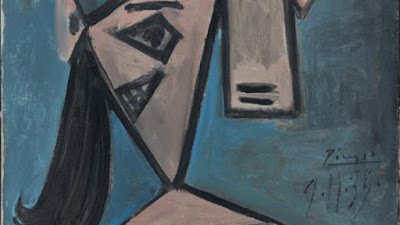Filenews 29 June 2021
Two paintings stolen in 2012 from the National Gallery, namely one by Picasso and one by Mondrian, are now in the hands of the police after a combined study of evidence gathered over the years.
The grand theft of the paintings was made in the early hours of January 9, 2012 by two people, one of whom entered the National Gallery by breaking an aluminium door, cut the paintings from the frames and escaped.
As announced yesterday, a 49-year-old Greek has been arrested by the Burglary Department of Attica Security in connection with the 2012 theft of the paintings from the National Gallery.
According to what has been known so far, the 49-year-old was identified by security officers after a combined study of the evidence gathered over the years and was brought to GADA where he confessed to his involvement in the theft and indicated to the police officers where he was hiding the two paintings. The paintings were reportedly found in Keratea at a point in a ravine packed and protected so as not to be damaged.
Which paintings were stolen
This is Picasso's painting "female head" that was crafted in 1939 and donated by the great painter in 1949 to the Greek people as an honorary offering for the brave resistance during the German occupation. The second is a 1905 painting by Dutchman Piet Mondrian depicting a windmill along the river "The Stammer Windmill" which was purchased in 1963 by Alexander Pappas who then donated it to the National Gallery.
In addition to the two paintings found, another work had been stolen from the National Gallery, namely a religious depiction of the Italian William Katsia for which nothing official has been announced by the police.
Today, 11.00am Chrysochoidis and Culture Minister L. Mendonis will give the Ministry of Citizen Protection a press conference on the subject.
The history of Picasso's painting
The "Women's Head", measuring 56×40 cm, created in 1939 by the Spanish painter, captures his muse, photographer Dora Maar, with whom he lived a tempestuous relationship for nine long years.
Dora Maar was the photographer who watched and immortalized with her lens the whole process of creating the work "Gernica", 1937 ("Guernica1/2"), while, due to her psychosynthesis, there was for Picasso the type of "crying woman".
Two and a half years after "Gernica", the "Women's Head" observes the same colour perception with which the pessimism of the Second World War period is expressed, according to "In the sanctuaries of the National Gallery: Unknown treasures from its collections".
Picasso, having experienced the Spanish Civil War, which was an inspiration for his most famous creation, "Gernica", decided to donate the "Women's Head" to the Greek people as an honorary contribution to his attitude towards fascism and Nazism during World War II.
«Pour le peuple Grec. Hommage de Picasso" (For the Greek people; Tribute from Picasso), mentions on the back of the canvas the dedication, dated 14/10/1939.
The Heist of the Century -The Stolen Picasso of the Gallery
The theft case has all the elements of a well-written police novel and is known in the police report as "the robbery of the century".
The paintings were stolen after 4 am. on January 9, 2012. The assailant misled the security guard, causing false alarms, and eventually managed to get inside the Gallery by breaking glass on the ground floor of the building. He grabbed the three paintings and then sat on the steps leading to the basement and with a knife removed the frames. His movements (he wore a cap to cover his features) were recorded by the Gallery's security cameras.
According to one version, a second person had taken part in the "operation" in the role of a lookout. The Investigation of the case involved the Hellenic Police, the Department of Prosecution of Antiquities and the EYP.
